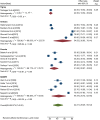Patterns of help-seeking behavior among people with mental illness in Ethiopia: a systematic review and meta-analysis
- PMID: 38563032
- PMCID: PMC10982478
- DOI: 10.3389/fpsyt.2024.1361092
Patterns of help-seeking behavior among people with mental illness in Ethiopia: a systematic review and meta-analysis
Abstract
Background: Despite the availability of evidence-based and effective treatments, significant numbers of people living with mental illness do not receive treatment or do not seek help from providers of formal modern treatment. Although numerous primary studies have been conducted on patterns of help-seeking behavior among individuals with mental illness with respect to modern therapy, the evidence has not been aggregated nationwide. Therefore, the aim of this review was to investigate pooled data on patterns of help-seeking behavior among individuals with mental illness in Ethiopia.
Methods: All available primary studies were searched via the Google Scholar, HINARI, and PubMed databases from June 22 to December 20, 2023; 912 articles were identified. Sixteen articles were included in the final review; data from them were extracted to an Excel spreadsheet and exported to Stata version 17 for analysis. The search terms used were: "Pattern of help-seeking behavior'' OR "Pattern of treatment-seeking behavior" OR "Health care-seeking behavior" OR "Help-seeking intention" OR "Help-seeking preferences" OR "Perceived need" OR "Pathways to psychiatric care", AND "Common mental disorders" OR "Mental illness" OR "Mental health problems" OR "Depression", AND "Predictors" OR "Determinate factors" OR "Associated factors", AND "Ethiopia". The quality of the studies included was critically appraised using the modified The Joanna Briggs Institute (JBI) Joanna Briggs Institute quality assessment tool, adapted for observational studies. During critical appraisal, disagreements between the two authors conducting the assessment were resolved by the involvement of a third author. Effect sizes were pooled using the random effects model, and the presence of publication bias was detected based on asymmetry of the funnel plot and a statistically significant result of Egger's test (p<0.05).
Results: The pooled rate of positive help-seeking behavior with respect to modern treatment among people living with mental illness was 42.21% (95% CI: 29.29, 55.12; I2 = 99.37%, P=0.00). Factors significantly associated with a positive pattern of help-seeking behavior were: having a secondary education or above (AOR=5.47, 95% CI: 2.33, 12.86); believing that mental illness requires treatment (AOR=2.76, 95% CI: 2.02, 3.78); having strong social support (AOR=2.00, 95% CI: 1.64, 2.44); having a family history of mental illness (AOR=2.68, 95% CI: 1.38, 3.97); having awareness of the availability of treatment (AOR=2.92, 95% CI: 1.56, 5.46); having previously engaged in positive help-seeking behavior (AOR=3.28, 95% CI: 1.63, 6.60); having comorbid disorders (AOR=4.25, 95% CI: 1.69, 10.66); not using alcohol (AOR=3.29, 95% CI: 1.73, 6.27); and the perceived severity of mental illness (AOR=2.54, 95% CI: 1.490, 4.33).
Conclusions: The majority of people with mental illness in Ethiopia exhibited a poor pattern of help-seeking behavior with respect to modern treatment. Therefore, mobilization of the community should be encouraged via regular public awareness campaigns regarding mental illness and the availability of evidence-based and effective modern treatment in Ethiopia. Moreover, the design of effective community-based mental health interventions is recommended in order to improve public attitudes and rates of help-seeking behavior in relation to mental health problems.
Keywords: Ethiopia; help seeking behavior; mental illness; systematic review and meta-analysis; treatment.
Copyright © 2024 Asnakew, Haile, Kassa, Ayehu, Beyene, Feleke, Endalew, Legas, Munie, Tedila, Shiferaw, Belete, Chanie and Aytenew.
Conflict of interest statement
The authors declare that the research was conducted in the absence of any commercial or financial relationships that could be construed as a potential conflict of interest.
Figures











Similar articles
-
The effect of substance use during pregnancy on neonatal outcomes in Ethiopia: A systematic review and meta-analysis.Heliyon. 2021 Apr 22;7(4):e06740. doi: 10.1016/j.heliyon.2021.e06740. eCollection 2021 Apr. Heliyon. 2021. PMID: 33997369 Free PMC article. Review.
-
Willingness to join community-based health insurance and associated factors among households in Ethiopian: a systematic review and meta-analysis.Cost Eff Resour Alloc. 2025 Apr 10;23(1):12. doi: 10.1186/s12962-025-00620-0. Cost Eff Resour Alloc. 2025. PMID: 40211299 Free PMC article. Review.
-
Prevalence and associated factors of sexual violence experienced by housemaids in Ethiopia: a systematic review and meta-analysis.Reprod Health. 2022 Jul 19;19(1):162. doi: 10.1186/s12978-022-01470-2. Reprod Health. 2022. PMID: 35854381 Free PMC article.
-
Diabetes mellitus among adults on highly active anti-retroviral therapy and its associated factors in Ethiopia: Systematic review and meta-analysis.Diabetes Res Clin Pract. 2021 Dec;182:109125. doi: 10.1016/j.diabres.2021.109125. Epub 2021 Nov 4. Diabetes Res Clin Pract. 2021. PMID: 34742783
-
Mothers' health-seeking practices and associated factors towards neonatal danger signs in Ethiopia: a systematic review and meta-analysis.BMJ Open. 2024 Nov 12;14(11):e086729. doi: 10.1136/bmjopen-2024-086729. BMJ Open. 2024. PMID: 39532356 Free PMC article.
Cited by
-
Mental health-related help-seeking and the role of HIV care providers: A qualitative study with people with HIV in Cameroon.PLOS Glob Public Health. 2025 May 15;5(5):e0004597. doi: 10.1371/journal.pgph.0004597. eCollection 2025. PLOS Glob Public Health. 2025. PMID: 40373052 Free PMC article.
-
Suicidal behaviours and associated factors among residents of Jimma Town, Southwest Ethiopia: a community-based cross-sectional study.BMJ Open. 2024 Sep 24;14(9):e085810. doi: 10.1136/bmjopen-2024-085810. BMJ Open. 2024. PMID: 39317502 Free PMC article.
-
Clusters of Patient Empowerment and Mental Health Literacy Differentiate Professional Help-Seeking Attitudes in Online Mental Health Communities Users.Health Expect. 2025 Feb;28(1):e70153. doi: 10.1111/hex.70153. Health Expect. 2025. PMID: 39815681 Free PMC article.
References
-
- Organization WH . The World Health Report 2000—Health Systems: Improving Performance. Geneva: WHO; (2000).
-
- Kerebih H, Abera M, Soboka M. Pattern of help seeking behavior for common mental disorders among urban residents in Southwest Ethiopia. Qual Prim Care. (2017) 25:208–16.
Publication types
LinkOut - more resources
Full Text Sources

